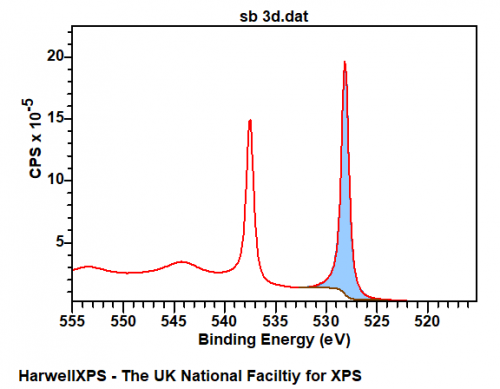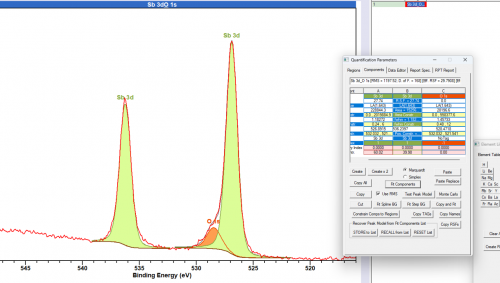
Antimony
Doublet Separations
- Sb 4d: 1.25 eV
- Sb 3d: 9.35 eV
- Sb 3p: 46.3 eV
The Energies Listed are Binding Energies!
- Sb 3d: 528 eV
- Sb 3p: 766 eV
- Sb 4s: 152 eV
- Sb 4p: 99 eV
- Sb 4d: 32 eV
The Energies Listed are Binding Energies!
Sb is primarily analyzed via the 3d orbital
- Dy MNN b (Al source) (517 eV)
- Re 4p1/2 (518 eV)
- Pt 4p3/2 (519 eV)
- V 2p1/2 (519.8 eV)
- Rh 3p1/2 (521 eV)
- O 1s (529.1 eV)
- Pd 3p3/2 (531 eV)
- Hf 4s (538 eV)
- Au 4p3/2 (546 eV)
Energies listed are Kinetic Energies!
Sb MNN: ~ 450 eV
The Energies Listed are Binding Energies!
| Species | Binding energy / eV | Charge Ref | Ref |
| Sb(0) | 528.1 | Au 4f (83.99 eV) | 1 |
Antimony exhibits a classic spin-orbit doublet, with no extraordinary concerns regarding photoemission.
Antimony systems are not known to interact in any significant way with experimental conditions during XPS analysis.
Care should be taken to record both the 3d 5/2 and the 3d 3/2 peaks when obtaining data for antimony based systems, since the 3/2 emissions will be vital in proper data handling of the 5/2 emission due to overlap with the O 1s feature.
Sb metal exhibits a modicum of asymmetry, for example – the clean Sb metal surface below may be fit with an LF(0.65,0.69,60,100,10) lineshape with the appropriate background. Important to note also, is the shake-up structure appearing at ~544 eV. The data below is available online via work from HarwellXPS technical director Dr. David Morgan at Surface Science Spectra.

Fitting of the overlapping (with O 1s) Sb 3d 5/2 peak is made easier through using the unaffected 3d 3/2 peak. Peak constraints may be used to fix the overlapping peak to the ‘free’ peak, particularly important in the case of multiple Sb states.

Not available
Not available
-
-
- Morgan, David J. “Metallic antimony (Sb) by XPS.” Surface Science Spectra 24.2 (2017). Read it online here.
-